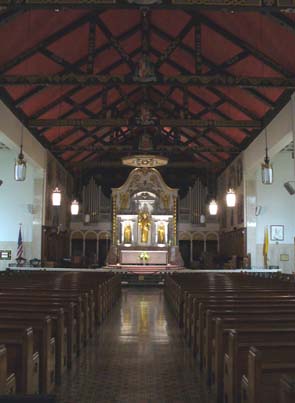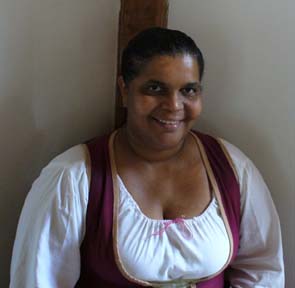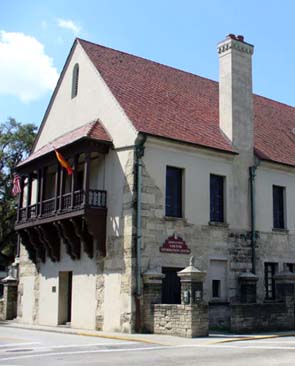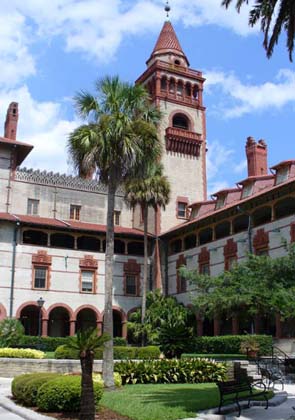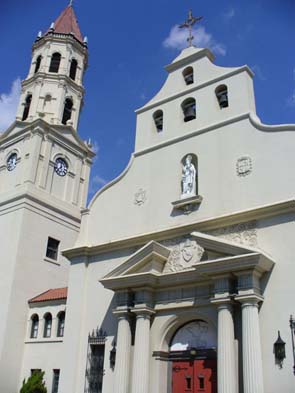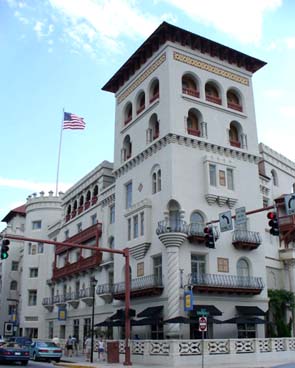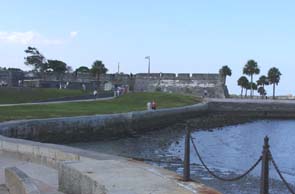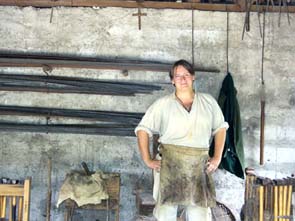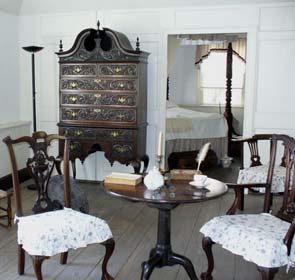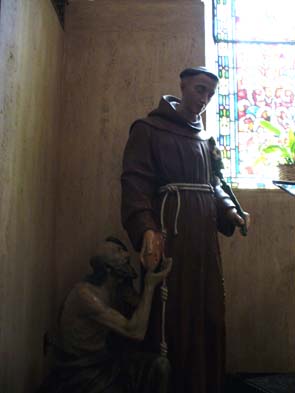| 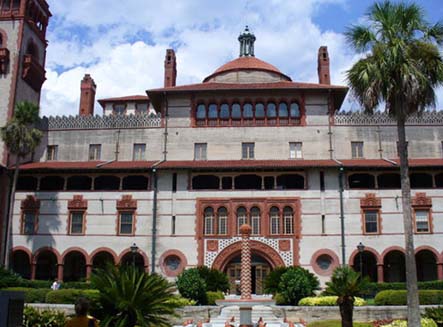
America's Oldest City
There are many reasons why St. Augustine
feels like a European city, and that European aura and influence
dates back 200 years. The story begins in 1513 when Juan Ponce de
Léon came to these shores and claimed St. Augustine as the
property of Spain.
In the age of the conquistadores
when the Spanish began discovering (and pillaging) silver and gold
in Mexico and Peru, there were many ships filled with those treasures
that stopped off the coast of Florida before making the daunting
return voyage across the Atlantic. As a result, the Spanish needed
to protect these fleets that sailed along the shores; to assure
they had at least a temporary safe haven.
Pedro
Menéndez, known as the founding father of St.
Augustine, was therefore sent by King Phillip of Spain to drive
out the French garrisons that had recently established a foothold
in this part of “The New World”. Along with more than
700 colonists and troops he landed on these southern shores with
the purpose of building a fort and a settlement to protect Spain’s
investments. Like so many other early American colonists, these
people faced starvation, harsh conditions, and pirate attacks; but
they managed to create a successful settlement.
It was the Spanish admiral Pedro Menéndez
de Avilés who on August 28, 1565 (the feast day of St. Augustine
de Hippo) officially founded the city, naming it in honor of the
saint. This achievement has earned St. Augustine the title of “America’s
Oldest City”; this nation’s oldest and continually occupied
European settlement. There were other settlements in the area before
this but they all failed.
This city has no shortage of battle scars.
In 1586, Englishmen Francis Drake burned the town to the ground,
but it was soon rebuilt. In 1668 St. Augustine was nearly destroyed
again by a pirate named John Davis. Yet again there were no quitters
here, and by order of Queen Regent Mariana of Spain, construction
on a new stone fort called Castillo de San Marcos began in 1672;
the construction continued for over 23 years. The fort was built
of coquina,
a locally quarried shell-rock which was ideal because it did not
crumble under cannon fire. The fort still stands today and is the
oldest man-made National Monument in the United States.
Like a tattered and battered veteran of war,
St. Augustine was sacked again in 1702 when English troops laid
siege to the new fort. For 50 days, the fort was fired upon, and
1500 citizens fled their settlement to the security offered by the
new coquina fort. Eventually, the British gave up, but
before they left they burned the rest of the town to the ground.
This is why there are no buildings in the city today that have been
around longer than 1702.
Once again the Spanish refused to give up,
and began reconstructing their settlement. Again in 1740, the English
attacked and a 27-day siege ensued. Another stalemate followed,
and eventually the English once more gave up trying to break through
the formidable defenses of the newly fortified walls and fort. With
their powerful cannons, the English had launched a heavy attack
on the fort but the coquina simply absorbed the cannon balls without
breaking apart.
However Spain’s fight for dominance
in this part of the Americas would again be forestalled. In Europe,
the Seven Years War ended in the defeat of Spain by the British,
and in 1763 the Treaty of Paris (often referred to as the Peace
of Paris or simply the Treaty of 1763) determined that it would
be England’s flag that flew over St. Augustine.
England divided the territory into two segments
and St. Augustine became the new capital of East Florida. The latter
geographically strategic area remained loyal to the British Crown
throughout the American Revolution.
But England’s occupation only lasted
21 years; and St. Augustine was then returned to Spain as part of
the negotiations that concluded the American Revolution. By the
second Treaty of Paris in 1783, the United States was recognized
as an independent nation, with British Canada to the north and Spanish
Florida to the south. The western boundary was the Mississippi River.
For the next 37 years, Spain ruled Florida.
However there was a great reluctance on the part of Spanish settlers
to leave Spain to battle the unknown, especially since a chaotic
state of affairs existed in the area. Violent clashes were occurring
between American-born settlers, Spanish citizens, British agents,
and Native American people in West Florida. This was followed by
the arrival of Andrew Jackson who, ignoring the international border,
burned native villages and executed two British subjects. He then
proceeded to capture St. Marks and Pensacola. The whole situation
was finally sorted out in 1821 when Florida was transferred from
Spain to the United States by the Adams-Onis Treaty. Jackson became
the Governor of this new U.S. Territory.
Peace in the area, however, was not to last
all that long. During the 1830s, the federal government and the
Seminole Indians began to clash in what has come to be known as
The Seminole War. The Seminoles were eventually defeated
and Florida became the 27th state of the Union in 1845.
Sadly, from 1875-1887, Native Americans from
the Southwest and Great Plains regions were captured and imprisoned
in the fort in St. Augustine. The government sought to educate them,
granting certain freedoms which some historians and other observers
have deemed actions that led to progressive Native American governmental
policies. Despite this dark period in St. Augustine’s history,
the city continued to flourish.
Over 200 years St. Augustine has endured
fire, turmoil, and strife. Five different flags have flown over
the city, and today you can still see each flag flying in St. Augustine,
a symbol of each part of the tale.
Just as Rome wasn’t built in a day,
St. Augustine took hundreds of years to become what it is today.
It is a city of many contrasts and cultural richness. Everyone from
Spanish colonists, British rulers, Native Americans, freed slaves,
and people just passing through have had a dramatic impact on this
place. In fact, as I reflect on what I have learned about St. Augustine,
I find it incredible that the beautiful 200-year-old buildings for
which the city is so well known, are still standing. This is a city
that seems to be able to withstand anything. Its stormy and turbulent
past is in part what gives it its grand presence today. And this
presence is in every historic home, museum, shop, restaurant, bed
and breakfast, and monument. Each part of St. Augustine expresses
its own piece of the history of this city.
Since so many of St. Augustine’s early
buildings still stand, you can experience a much richer, older history
(through architecture, art, stories, and people) than you would
in other cities of the United States. The
Spanish colonial influence is still much in evidence as you walk
through the streets of this town.
For a short time during my visit, I almost
forgot that I was in the the United States. It was as if I was in
a European town with cobbled streets, stunning architecture, exotic
culinary treats, tempting boutiques, a serene natural setting —
and most importantly, illuminating stories from the past.
Historical sites in St.
Augustine that stimulated my imagination
Understanding the who, what, where, and when
of history is important to gaining a perspective on an archival
destination such as St. Augustine. However in my experience, the
imagination also plays an important role. In such experiential and
life-long learning destinations, I find that I inevitably experience
a need to see through my mind's eye the events that occurred here;
and to sense the people who inhabited the place in centuries past.
In St. Augustine, this kind of full integration of the senses and
the mind is very much a part of the travel experience.
Castillo
de San Marcos National Monument
The
Colonial Spanish Quarter
The
Oldest Wooden Schoolhouse in the United States
The
Oldest House in the United States
St.
George Street (shops, restaurants, and all the history of the Spanish
quarter
Ponce
de Leon’s Fountain of Youth
The evocative architecture
of St. Augustine
Henry Flagler had a profound impact on the
architecture of St. Augustine. The co-founder of Standard Oil (along
with John D. Rockefeller), he was of course incredibly wealthy and
first visited the city during the winter of 1888-84.
He was immediately charmed by the area and
thought the city had enormous potential. However, he found the hotels
and public transportation inadequate for what he recognized as a
potential travel destination. He was so passionate about his ideas
that he ultimately gave up his day-to-day responsibilities at Standard
Oil to pursue his projects in St. Augustine. He built the 540-room
Ponce de Léon hotel and then purchased the Jacksonville,
St. Augustine & Halifax Railroad, the first section of what
would eventually become the Florida East Coast Railway. Although
he has been called the “Father of Miami” and was involved
in many other aspects of Florida’s history, I believe his
influence can best be seen in St. Augustine.
Some “Flagler”architectural
points of interest:
Flagler
College (Formerly the Hotel Ponce de Léon built
by Henry Flagler)
Casa
Monica Hotel (Formerly the Cordova Hotel built by Flagler)
Lightner
Museum (Formerly the Alcazar Hotel built by Flagler)
Memorial
Presbyterian Church (Built in 1889 as a memorial to
Flagler’s daughter)
St. Augustine as
an art lover's
mecca
It’s no surprise that a place that
is so rich in culture and beauty has inspired artists over the years.
In fact, from the 1930s through the 1950s, St. Augustine had a thriving
arts community that attracted hundreds of artists. The city eventually
became the largest art colony in the southern U.S. through the efforts
of a small group of artists who founded the St. Augustine Arts Club
in 1931. In 1934, it changed its name to the Arts Club of St. Augustine
and then became the Art Association of St. Augustine in 1948. Local
businessmen and retailers who understood that cultivating the arts
was a way to promote economic development supported the association.
Today, the arts community is still flourishing with over 25 galleries
and studios in the area.
Some arts “destinations”
in St. Augustine
The
St. Augustine Art Association (Changing competitive
shows, plus permanent collection gallery)
Butterfield
Garage Art Gallery (Contemporary work by award-winning
member artists)
Absolute
Americana Art Gallery (Original artworks from influential
21st century artists; includes a permanent exhibit of Pierre Henri
Matisse)
Carrera
Gallery (The art gallery of Flagler College)
The culinary culture
of St. Augustine
One of the best ways to discover a destination's
a story is by experiencing its culinary possibilities. All of the
ethnic groups that have passed through this city have left their
mark, and dining in St. Augustine is a gastronomic experience par
excellence. Spanish, Italian, French, Greek, German, Asian,
Swiss, and Southern Florida Cracker are all represented here. Fine
dining, casual eating, and gourmet bistros are everywhere, and many
of feature world-renowned chefs.
A few that I highly recommend
Palm
Café & Bakery (Chef Aaron Miles, features
gourmet dining and a relaxed ambiance.)
Kingfish
Grill (Fine cuisine and a beautiful view of the Intracoastal
Waterway)
Claude’s
Chocolate (Hand-made chocolate by a renowned French
chef)
Athena
Restaurant (St. Augustine’s premier Greek restaurant)
“Organic”
St. Augustine
Enjoying the great outdoors is a part of
the authentic St. Augustine experience: hiking, biking, kayaking,
sailing, shell collecting, parasailing, fishing, and surfing are
just some of the activities available for outdoor enthusiasts. A
quiet walk on the city's pristine beach will clear your mind. During
a sea kayaking excursion, my tour guide regaled me with tales from
St. Augustine’s past. Floating on the surface of the ocean
in a kayak is such a calming and serene experience; and a welcome
break from the intense and thoughtful sightseeing tours.
For outdoor enthusiasts
Kayak
tours (One of my favorite activities)
Nature
Boat tours (A great way to see dolphins)
Schooner
Freedom (A romantic sail on a replica of a 19th -century
schooner)
Ghost
Tours (A great way to enjoy the night air and some
thrills and chills)
The
Red Train (Catch the Red Train and learn the layout
of the land; and a lot about history)
Classic accommodation
in St. Augustine
There is no shortage of unique places to
stay in St. Augustine. The most fascinating places (in addition
to Henry Flagler’s hotel legacies) are the quaint and often
mysterious bed & breakfasts that are everywhere in the city.
For a more personal experience, I recommend staying at one of the
latter. Almost all of them are stories in themselves, and their
owners have a lot of genuine pride as well as knowledge about their
hometown. Along with beautiful furnishings, quiet ambiance, and
luxury treatment, all of these bed and breakfasts have something
different to offer. The fact that some of them are haunted only
adds to the lure of each place.
Places to stay
Casa
de la Paz
St.
Francis Inn
Bayfront
Marin House
Bayfront
Wescott House
Inn
on Charlotte Street
Casa
de Solana
Casablanca
Inn
Enduring St. Augustine
It is no wonder that so many people choose
to return to St. Augustine time and again. There are so many layers
to uncover in this city. St. Augustine is what I love most about
the places I’ve been to in Europe; the elegant beauty of blending
the old with the new; the integration of history and culture; and
the very real effect this meaningful atmosphere has on the people
of St. Augustine. This is a thoughtful city. How fortunate for me
that St. Augustine happens to be in my part of the world.
For More Information
The
Official Website for the City of St. Augustine
St.
Augustine's Old City
St.
Augustine, Ponte Vedra & The Beaches Visitors & Convention
Bureau

|


